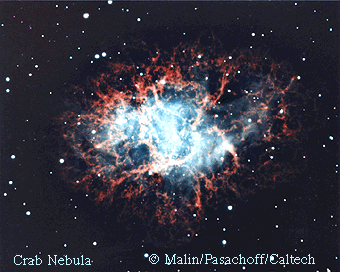
|
Explanation: The Crab Nebula resulted from a star that exploded - a supernova. The outer layers of the star were thrown violently into space, while the inner core collapsed to form a neutron star. This neutron star is visible to us today as a pulsar - a rotating star at the center of the nebula that emits visible flashes of light. The Crab Pulsar flashes about 30 times every second. Although the stellar explosion that caused the Crab Nebula was seen over 900 years ago, the nebula itself still expands and shines. How the nebula obtains the energy needed to shine was a mystery eventually solved by noting that this energy could be released by the slowing of the pulsar's rotation.
|
January February March April May June July August September October November December |
| ||||||||||||||||||||||||||||||||||||||||||||||||
NASA Web Site Statements, Warnings, and Disclaimers
NASA Official: Jay Norris. Specific rights apply.
A service of: LHEA at NASA / GSFC
& Michigan Tech. U.
Based on Astronomy Picture
Of the Day
Publications with keywords: M 1 - Crab Nebula
Publications with words: M 1 - Crab Nebula
See also:
- APOD: 2025 August 24 Á The Spinning Pulsar of the Crab Nebula
- M1: The Incredible Expanding Crab
- APOD: 2024 July 23 Á The Crab Nebula from Visible to X Ray
- M1: The Crab Nebula
- APOD: 2023 March 20 Á M1: The Expanding Crab Nebula
- APOD: 2023 January 15 Á M1: The Crab Nebula from Hubble
- The Spinning Pulsar of the Crab Nebula
